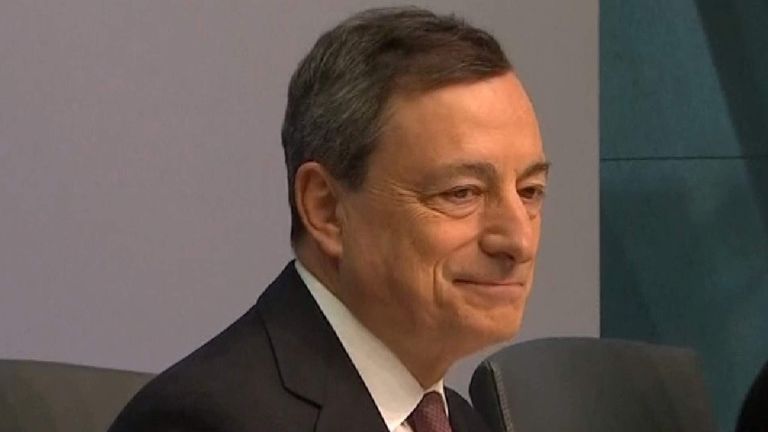Draghi medicine and 'sod it' factor credited for eurozone growth
Sky's Ian King examines the latest growth figures for the countries using the euro and sees several factors behind the recovery.
Tuesday 31 October 2017 15:14, UK
Amid all the cacophony over Donald Trump's presidency and the Brexit negotiations, it would be easy to ignore that this has actually been quite a good year for the global economy.
This is the first year since the financial crisis that there has been synchronised growth in all of the world's major economic areas - the United States, China, Japan and, of course, the eurozone.
The latter's strength this year has been the major surprise for economists.
There were that, after years of malaise, the 19-country bloc was poised to finally enjoy solid growth this year.
That has been confirmed throughout the year with some encouraging figures and today brought more of the same, with news that the euro area grew by 0.6% between July and September, better than the 0.5% that had been expected by economists.
That actually represents a modest slowdown from the 0.7% quarter-on-quarter growth that was notched up between April and June. But it still means year-on-year growth in the bloc was 2.5%, again, better than the 2.4% that had been expected.
Accompanying this was news that the jobless rate in the eurozone fell in September to 8.9%, its lowest since January 2009, when the world was in the grip of the financial crisis.
Unemployment fell in every member country apart from Lithuania, where it rose slightly and Finland, where it was unchanged.
The jobless rate remains sharply higher that the bloc's average in countries such as Greece and Spain, which were at the heart of the sovereign debt crisis five summers ago, but even there the rates have been falling dramatically.
For example, unemployment in Spain has fallen from 19.1% to 16.7% during the last year, while in Cyprus it has come down from 13% to 10.3%.
As yet, we have not had the entire breakdown from within the eurozone, with the likes of Germany and Italy not due to publish their individual GDP data for another fortnight.
The detail released thus far, though, has been eye-catching.
France, for example, enjoyed 0.5% quarter-on-quarter growth and an annual growth rate of 2.2%, which is easily its best growth since 2011, putting it ahead of Britain.
Also striking was the 0.8% quarter-on-quarter growth achieved in Spain which, during the last year, has seen its economy grow by 3.1% - although this covers a period prior to the Catalan referendum which, Madrid has said, is likely to hit growth during the final three months of the year.
What is especially striking about this rate of growth from the eurozone is that it comes in the face of the euro's sharp rise in value this year.
The single currency has been the best performing of the major "G10" currencies this year which, all other things being equal, should make its exports less competitive. But it doesn't appear to have happened.
So what's behind this growth? A large part of it has to be down to the medicine prescribed by Mario Draghi, President of the European Central Bank, who attracted derision when, five years ago, he said he would do "whatever it takes" to tackle the sovereign debt crisis.
"Whatever it takes" turned out to be a €2.6tn programme of asset purchases - Quantitative Easing in the jargon - to stimulate demand.
It has finally worked to the extent that, last week, Mr Draghi announced he was from €60bn a month to €30bn a month from next January onwards.
There has also been what some investment professionals call the "sod it factor" - in other words, after months and years of sitting on their hands because things are so bad, consumers and businesses finally decide that they may as well go out and start spending and investing again.
A revival of consumer spending in Germany has been a key indicator here.
Despite a slight slowdown in recent months, consumer spending in Germany has overtaken exports as the key driver of growth, reflecting record low unemployment, rising wages and improving job security.
Thirdly, there will also have been an injection of confidence in some economies.
The election of the business-friendly Emmanuel Macron as French president, along with the re-election of Angela Merkel in Germany and Mark Rutte in the Netherlands this year have marked a resounding snub to extremists of both the Right and the Left.
The eurozone has overcome all major political hurdles this year, although the Catalan situation remains of concern, while concern over the kind of trading relationship the eurozone's major economies will have with Britain post-Brexit will also cast a shadow.
All is not yet rosy in the euro area garden.
Inflation, at just 1.4%, remains worryingly low. That is particularly surprising in view of the big drop in unemployment and suggests that, in many eurozone economies, wage growth remains becalmed.
But it has been a much better year than many would have hoped.






